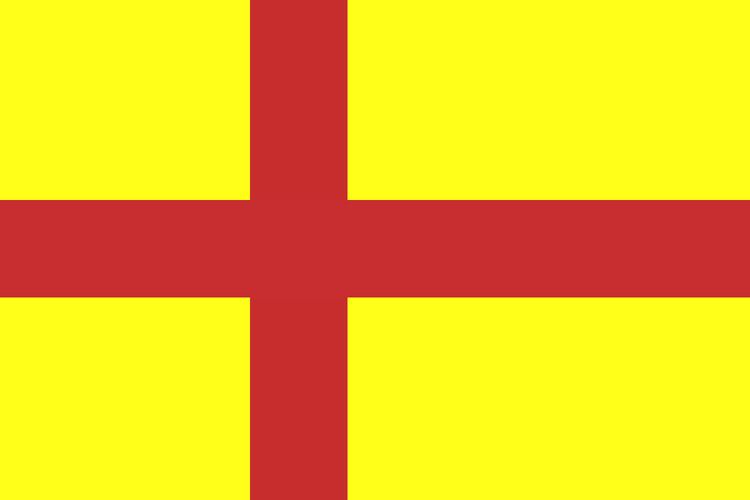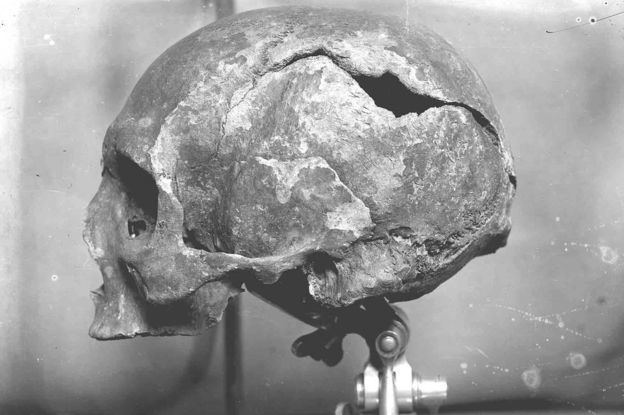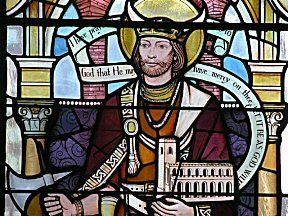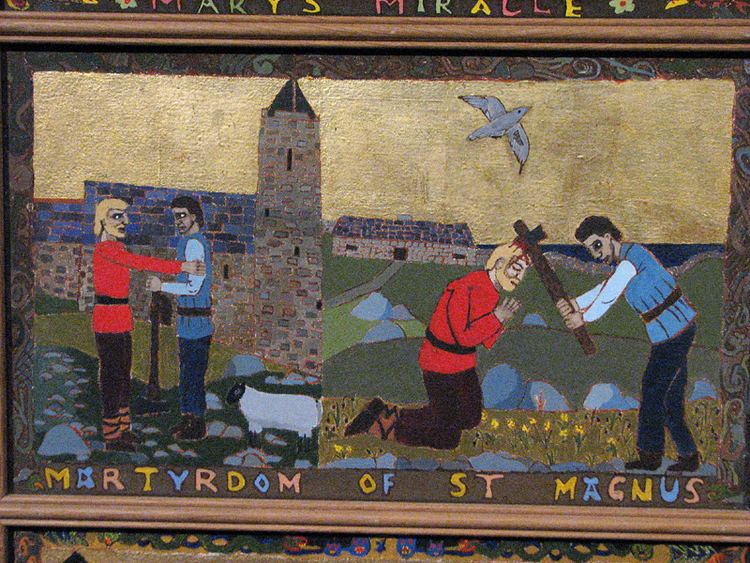Name Magnus Earl | Grandparents Thorfinn the Mighty | |
 | ||
Parents Paul and Erlend Thorfinnsson People also search for Torf-Einarr, Rognvald Brusason | ||
St magnus cathedral kirkwall
Saint Magnus Erlendsson, Earl of Orkney, sometimes known as Magnus the Martyr, was Earl of Orkney from 1106 to about 1115.
Contents

Magnus's grandparents, Earl Thorfinn and his wife Ingibiorg Finnsdottir, had two sons, Erlend and Paul, who were twins. Through Ingibiorg's father Finn Arnesson and his wife, the family was related to the Norwegian Kings Olav II and Harald II.

His story is told in three Icelandic sagas: Orkneyinga saga (chapters 34–57); Magnús saga skemmri; and Magnús saga lengri. There are also two surviving Latin accounts of his life. An early medieval Latin life no longer survives, but was incorporated into Magnús saga lengri.

Early life

Born in 1080, Magnus was the first son of Erlend Thorfinnsson, Earl of Orkney. Erlend and his brother Paul ruled jointly. In 1098, King Magnus Barelegs of Norway took possession of the islands and deposed Erlend and Paul, installing his illegitimate son Sigurd as ruler. From Orkney, King Magnus set out for a raiding expedition along the west coast of Scotland, taking Magnus Erlendsson and Paul's son Haakon with him. Magnus first served Magnus of Norway as skutilsvein (approx. Chamberlain). Haakon, then became regent on behalf of the Norwegian prince, Sigurd, who made Haakon earl in 1105.
Battle of Anglesey Sound

According to the Orkneyinga Saga, Magnus had a reputation for piety and gentleness, which the Norwegians viewed as cowardice. He refused to fight in a Viking raid in Anglesey, Wales, because of his religious convictions, and instead stayed on board the ship during the Battle of Anglesey Sound, singing psalms. He was obliged to take refuge in Scotland, but returned to Orkney in 1105 and disputed the succession with his cousin Haakon.
Having failed to reach an agreement, he sought help from King Eystein I of Norway, who granted him the earldom of Orkney and he ruled jointly and amicably with Haakon until 1114.
Their followers fell out, and the two sides met at the Thing (assembly) on the Orkney mainland, ready to do battle. Peace was negotiated and the Earls arranged to meet each other on the island of Egilsay at Easter, each bringing only two ships. Magnus arrived with his two ships, but then Haakon treacherously turned up with eight ships.
Death
Magnus took refuge in the island's church overnight, but the following day he was captured and offered to go into exile or prison, but an assembly of chieftains, tired of joint rule, insisted that one earl must die. Haakon's standard bearer, Ofeigr, refused to execute Magnus, and an angry Haakon made his cook Lifolf kill Magnus by striking him on the head with an axe. It was said that Magnus first prayed for the souls of his executioners.
According to the sagas, the martyrdom took place after Easter, on 16 April. The year is often given as 1115, but this is impossible as 16 April fell before Easter that year. Sigurd Towrie follows Orkney Historian Gregor Lamb in placing the death of Magnus in 1118. The best authorities now give the date at 1117 and his 900th anniversary has been commemorated in his Cathedral in Kirkwall in the Orkneys in 2017.
Burial
Magnus was first buried on the spot where he died. According to his legend, the rocky area around his grave miraculously became a green field. Later Thora, Magnus' mother, asked Haakon to allow her to bury him in a Church. Haakon gave his permission and Magnus was then buried at Christchurch at Birsay.
There were numerous reports of miraculous happenings and healings. William the Old, Bishop of Orkney, warned that it was "heresy to go about with such tales" and was then struck blind at his church but subsequently had his sight restored after praying at the grave of Magnus, not long after visiting Norway (and perhaps meeting Earl Rognvald Kolsson).
In 1136 Bishop William of Orkney sanctified the murdered Earl Magnus, making him Saint Magnus. It is thought probable that St Magnus Church, Egilsay, was constructed on the island shortly afterwards, at or near the supposed site of the murder. This may have replaced an earlier church which could have already been there at the time of the murder of Magnus.
Magnus's nephew, Rognvald Kali Kolsson, laid claim to the Earldom of Orkney, and was advised by his father Kol to promise the islanders to "build a stone minster at Kirkwall" in memory of his uncle the Holy Earl, and this became St Magnus Cathedral, Kirkwall. When the cathedral, begun in 1137, was ready for consecration the relics of St Magnus were transferred, and in 1919 a hidden cavity was found in a column, containing a box with bones including a damaged skull. These are held without (much) doubt to be the relics of St Magnus.
In the Faroes, the St Magnus Cathedral, Kirkjubøur was built around 1300 A.D., at the time of Bishop Erlendur. It is quite sure that the church was used for services (though it never was finished, or has been destroyed later), for estimated relics of Saint Magnus were found here in 1905. Kirkjubøur is one of the most important Faroese historical sites and expected to become a World Heritage Site. In total there are 21 churches in Europe dedicated to St Magnus.
There are two Icelandic sagas of St Magnus's life, Magnus' saga - the shorter, and the longer account given in the Orkneyinga Saga. In addition to this there are several devotional works in Gaelic and Latin about St Magnus, including a legend, Legenda de sancto Magno. Saint Magnus is the subject of the novel Magnus by Orcadian author George Mackay Brown, which was published in 1973,St Magnus, Earl of Orkney by John Mooney, and "Saint Magnus, the Last Viking" a novel for young adults by Susan Peek, published in 2016. In 1977 Peter Maxwell Davies wrote a one-act opera, The Martyrdom of St Magnus, based on Mackay Brown's novel. In 1989 the English composer Clive Strutt who lives on the Orkney island of South Ronaldsay composed THREE HYMNS In Praise of Saint Magnus based on a 12th-century theme existing in Uppsala University, Sweden.
